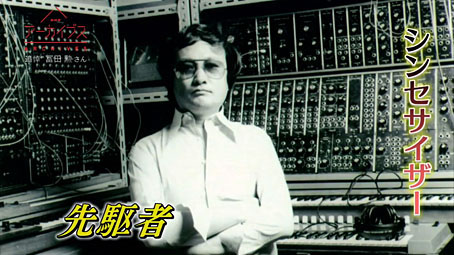
In the week that celebrates the 50th anniversary of the Apollo 11 mission to the Moon here’s a cosmic flashback from 1984. (I wrote about my own memories of the Apollo era in July, 2009.)
Mind Of The Universe was an ambitious outdoor performance of music by Isao Tomita for the annual Ars Electronic Festival in Linz, Austria. I’d known about this event ever since the release of the subsequent live album, and always wondered if there was more of a visual record than the one or two short clips to be found on YouTube. This 65-minute documentary from NHK TV was made following Tomita’s death in 2016, and features a much longer recording of the concert, together with a look at the preparations undertaken by the composer and his Japanese team. The documentary is in Japanese throughout, but I’ve had Tomita’s albums on continual play for the past couple of weeks so it was a welcome discovery. The Linz footage is bracketed by a short studio discussion of Tomita’s work and the concert itself with two of his assistants, Hideki Matsutake and Akira Senju. Matsutake is better known for his programming work with Yellow Magic Orchestra, and his own albums under the name Logic System, but he began working with synthesizers as Tomita’s studio assistant in the 1970s; Senju is a composer of anime soundtracks. The documentary includes some all-too-brief film footage of Tomita’s studio in 1974, and a sequence (with Tomita-san on a motorbike!) concerning the Dawn Chorus (1984) album which incorporated recordings of the electromagnetic “Dawn Chorus” phenomenon.
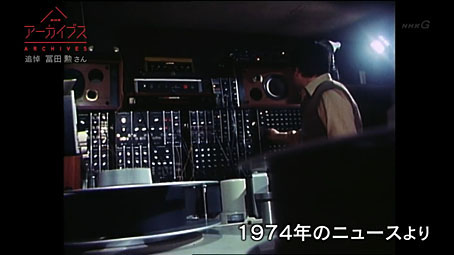
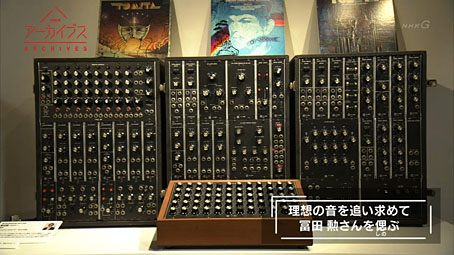
Part of Tomita’s Moog system, the backbone of his early electronic recordings.
Mind Of The Universe (or Tomita’s Universum as it was advertised to the citizens of Linz) comprised a nocturnal performance spanning the River Danube, with Tomita combining some of his earlier recordings with new pieces created for the event, including an extract from Stravinsky’s Rite of Spring. This was conducted by the maestro and assistants from within a transparent pyramid suspended by crane on the river bank. Speakers were positioned on both banks of the river, and there was a lavish lightshow with fireworks and lasers, all of which was somehow meant to depict the entire history of the Universe, from Big Bang to the present moment.
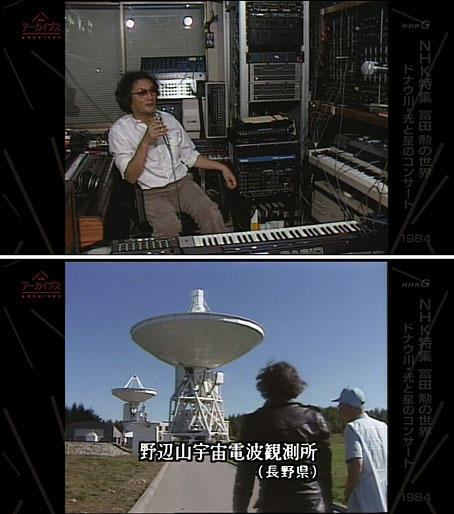
Discussing Dawn Chorus, and a visit to a radio telescope.
If this wasn’t ambitious enough, Tomita had musicians and a choir floating on boats and platforms in the river: Goro Yamaguchi played a traditional Japanese piece on shakuhachi while seated in a perilously small craft being towed behind a larger vessel; the bigger boat provided a stage for violinist Mariko Senju whose excellent performance of Vaughan Williams’ The Lark Ascending is the musical highlight of the concert. This was followed by a violin rendition of the five-note motif from Close Encounters of the Third Kind, a nod to Tomita’s UFO-themed Bermuda Triangle album, which introduced one of the less successful aspects of the event in the noisy arrival of a helicopter bearing a platform laden with lights and speakers. The helicopter provided the booming response of the Close Encounters mothership although this isn’t obvious on the live album where all you have is the music and the noise of the rotors. Tomita’s concept of “pyramid sound” is more evident in the TV documentary than on record.
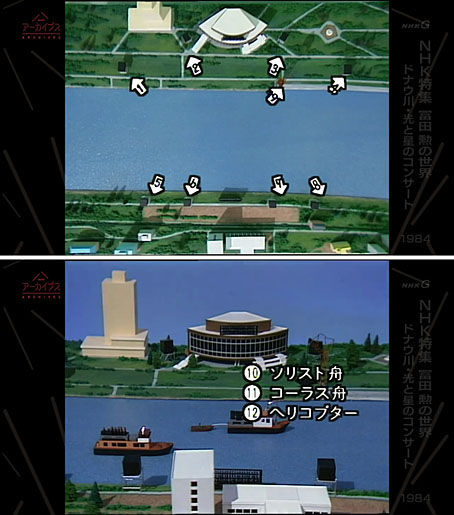
The Linz plan showing the positioning of the speakers and musicians.
The Linz concert was the most extravagant example of Tomita’s obsession with multi-channel audio in general, and “pyramid sound” in particular. Many of the Tomita albums in the 1970s received quadrophonic releases, while in the 90s an entire series of CDs were issued with Dolby Surround encoding. These were produced before SACD-style hybrid discs so they’re fine if you have a multi-channel amplifier but the encoding ruins the music for anyone who doesn’t by burying portions of the music in the stereo mix. “Pyramid Sound” was Tomita’s own invention, described as follows on the Bermuda Triangle album:
This album is different from my others in that the master was recorded onto five tracks. Ideally, it should be heard through five speakers, four in the conventional rectangle and the fifth suspended above the centre—thus a sonic pyramid. Although it is impossible to encode this onto a phonograph record, as much as possible of the five-channel effect has been incorporated into standard discs through the help of the engineering staff of Japan Victor.
Impossible on record, and not much better in a live context although it did actually work at Linz. An overhead speaker wouldn’t be difficult to arrange for an indoor event but the solution outdoors necessitated the intrusive helicopter. I wonder now why they didn’t use a balloon or airship of some sort when helicopters are notoriously noisy. One of the minor revelations of the documentary is that the helicopter speakers weren’t originally loud enough when they were being tested. The helicopter returns for the climax of the concert, the overhead speakers this time delivering the “O Freunde, nicht diese Töne…” bass introduction from Beethoven’s Ode To Joy. In 1984 I was hoping that Tomita’s take on Beethoven’s Ninth might be on a par (or even improve upon) the remarkable Moog version that Wendy Carlos and Rachel Elkind created for A Clockwork Orange. This isn’t the case, unfortunately, in fact it’s a version I don’t like to hear at all since Tomita unwisely added a drum rhythm to the music. Drum rhythms on previous Tomita albums were either used for comic effect (the theme from Star Wars) or because they were justified by the music (Ravel’s Bolero); imposing a rhythm on the Ode To Joy is the kind of thing you’d expect from a cheap advertising jingle.
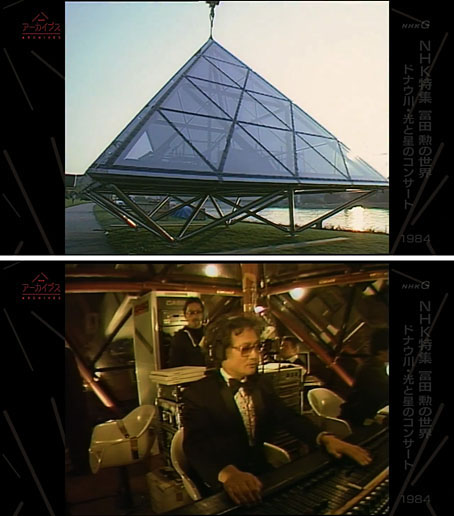
The control pyramid. Pyramid mania was one of the more peculiar fads of the 1970s, and one Tomita shared with Todd Rundgren and Steve Hillage.
Setting aside the complaints, this is still a fascinating documentary for any Tomita enthusiast, especially those of us in the West for whom Tomita was always a remote figure, seldom interviewed anywhere, and never seen on TV. For those unfamiliar with his music I’d suggest starting with his cosmic masterpieces The Planets or The Bermuda Triangle. If you can create a pyramid speaker system in your home then so much the better but it’s not essential.
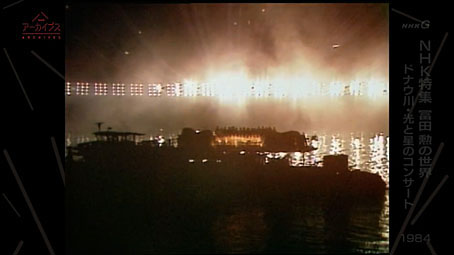
Previously on { feuilleton }
• Tomita album covers

Wow…serendipity – I just found three of his records in a thrift store in Durham, North Carolina. Special joy was the artwork on the cover of THE PLANETS…